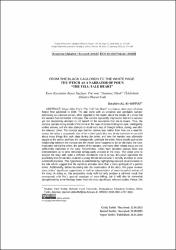From The Black Cauldron to The White Page: The Witch as a Narrator of Poe’s “The Tell-Tale Heart”
Citation
AL-KHAFFAF, İbrahim. "From The Black Cauldron to The White Page: The Witch as a Narrator of Poe’s “The Tell-Tale Heart”". Trakya Üniversitesi Edebiyat Fakültesi Dergisi, 14.27 (2024): 175-189.Abstract
Edgar Allan Poe’s “The Tell-Tale Heart” is a famous short story of crime fiction first published in 1843. The tale starts with an unnamed and unreliable narrator addressing an unknown person, often regarded as the reader, about the details of a crime that the narrator had committed in the past. The narrator repeatedly emphasizes that she is nervous yet she desperately attempts to rid herself of the accusation that she is insane. Thus, the narrator narrates many details of the crime in the hope of demonstrating her sane, intelligently crafted actions, and she also attempts to detail each step of thought before, during, and after the relevant crime. The narrator says that her motive was neither from hate nor a need for money but rather a suspenseful fear of the victim’s pale blue eye. In the narration we are told about many things that took place during the crime, and how the narrator was ultimately caught by the police, and how she consequently confessed the crime. Many details such as the relationship between the narrator and the victim (who happened to be an old man), the clear motivation behind the crime, the gender of the narrator, and many other related issues are not sufficiently explained in the story. Nevertheless, critics have provided various ideas and interpretations as to what remained ambiguously unstated in the story. This paper aims to analyse the story with quite a different standpoint, that is to say, this paper signalizes the possibility that the narrator could be a young female servant who is secretly involved in some witchcraft practices. This hypothesis is established by highlighting relevant ritual elements in the tale which suggest that the narrative includes more than a mere portrayal of a perfect crime. Additionally, before launching into the examination of the story, this paper reviews some critics’ significant suppositions as well as interpretations of some inexplicit notions of the story. In doing so, this prospective study will not only produce a coherent result that corresponds with Poe’s general paradigm of story-telling, but it will also be somewhat strengthened by some findings drawn from the most significant, relevant studies. Hence, this paper will create a new spiritual reading that will fill in the resultant gaps in the studies that engaged this short story. And this will be achieved by linking—for the first time—this story with witchcraft. Edgar Allan Poe’nun ilk kez 1843’te yayımlanan “Gammaz Yürek” adlı eseri ünlü bir polisiye öyküdür. Hikâye, isimsiz ve güvenilmez bir anlatıcının, genellikle okuyucu olarak kabul edilen bilinmeyen bir kişiye, anlatıcının geçmişte işlediği bir suçun ayrıntıları hakkında hitap etmesiyle başlar. Anlatıcı kendisine isnat edilen deli yakıştırmasından duyduğu kızgınlığı defalarca vurgularken bir yandan da çaresizce akli dengesinin yerinde olduğunu kanıtlamaya çalışır. Bu sebeple, cinayetin öncesinde, esnasında ve sonrasında ne düşündüğünü ve nasıl hissettiğini cürmün bütün ayrıntılarına yer vererek itiraf eder ve kurbanını akıllıca tasarlayarak öldürdüğünü dile getirir. Anlatıcı suçunu tetikleyen sebebin kurbana karşı duyduğu bir kin ya da maddi bir ihtiyaç olmadığını; yalnızca maktulün soluk mavi renkteki bir gözünün kendisinde yarattığı ikircikli bir korkudan kaynaklandığını ifade eder. Hikâyede suç işlenirken meydana gelen birçok olaya, sonrasında failin polis tarafından nasıl yakalandığına ve suçunu neden itiraf ettiğine değinilir. Anlatıcı ile (yaşlı bir adam olan) kurban arasındaki ilişki, suçun arkasındaki açık motivasyon, anlatıcının cinsiyeti ve diğer burayı çıkaralım birçok detay hikâyede yeterince açıklanmamıştır. Bununla birlikte, eleştirmenler, hikâyede muğlak kalan noktalara dair bazı fikirler ortaya atıp çeşitli yorumlarda bulunmuşlardır. Bu makale, hikâyeye oldukça farklı bir perspektiften bakmayı amaçlamaktadır, yani bu makale, anlatıcının, bazı büyücülük uygulamalarına gizlice karışan genç bir kadın hizmetçi olabileceği ihtimaline işaret eder. Bu hipotez, anlatının mükemmel bir suç tasvirinden daha fazlasını içerdiğini öne süren masaldaki ilgili ritüel unsurların altı çizilerek kurulacaktır. Ek olarak, öykünün incelenmesine başlamadan önce bu makale, bazı eleştirmenlerin önemli varsayımlarının yanı sıra öyküyle ilgili açık olmayan bazı kavramların yorumlarını da gözden geçirecektir. Böylelikle, bu çalışma Poe’nun öykücülüğünün genel paradigmasıyla tutarlı bir sonuç üretmekle kalmayacak, aynı zamanda gelecekteki ilgili ve önemli diğer çalışmaların bulgularıyla güçlenecektir. Ayrıca, bu çalışmada bahse konu olan öykü ile ilgili yapılan çalışmalardan kalan bir boşluğu ruhani yeni bir okumayla ilk defa cadılık ile ilişkilendirerek dolduracaktır.



















